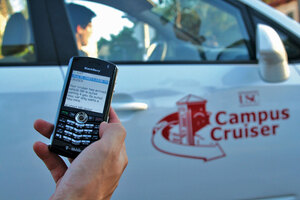Cruiser aims to end missed pickups
One night last year, Noel Arreola, an undecided sophomore, waited for a Campus Cruiser that never came.
“A cruiser never came at all and I ended up walking because I wasn’t sure what had happened,” Arreola said.

Cellular · Students using Campus Cruiser will now receive a text or a call when the cruiser arrives, rather than waiting for it outside. - Carlos Acenas | Daily Trojan
Another time last year, Arreola called Campus Cruiser, a free taxi service for USC students, before it closed and was still on hold at
2:45 a.m., past the program’s hours of operation.
But this past Saturday night, Arreola received a phone call to notify her that her cruiser had arrived at her pickup location, part of Campus Cruiser’s new initiative to notify students with an automated text message or phone call once their cars have arrived.
The changes to the Campus Cruiser system mean students will no longer have to wait outside for their rides or miss pickups altogether — an issue that was common before this fall.
“For whatever reason, people were missing their cruisers, so we thought this was a better way they could get to Cruiser on time,” said Campus Cruiser Manager John Zajac.
Campus Cruiser started the system at the recommendation of USC students and tested it during the summer.
Cruiser is also providing a new phone line that allows students to immediately check the status of requested rides by putting in a confirmation number or the first letters of their last name.
“Based on feedback from students, USG, URSC, and really from all campus cruisers that work in the program, it came to our attention that it was something that the students really wanted,” said Tony Mazza, director of USC Transportation.
During the initial testing stages, Zajac said the service provider was not consistently sending the callback messages to students, but since the start of this semester, most students seem to be receiving their notifications.
“Everyone is extremely pleased with the program … the reliability has been 100 percent and I think it’s going to be a huge enhancement to the program,” Mazza said.
After analyzing data from the first week of the school year, Mazza said the automated phone callback was requested more often than the text message.
Between Thursday and Sunday, Mazza said, Cruiser recorded 1,345 telephone notifications and 493 text message notifications.
Mazza added that the first weekend of the academic year is typically the busiest for Campus Cruiser.
Campus Cruiser received 4,064 calls during the first week of classes from August 24-30, Mazza said.
The notification system also seems to have made Cruiser more efficient, and Zajac said fewer students have been missing their cruisers.
Cruiser driver Julius Cotton, a junior majoring in business and critical studies, said he thinks it is unsafe for students to wait outside for five to 10 minutes for a car later at night, especially alone.
Cotton said he thinks the new notification system that goes directly to the students even if they aren’t outside, will help solve that issue.
“It will make sure that people are getting their cruisers and it will also increase safety because people aren’t just being left stranded, as some people might have felt before,” said driver Alyssa Whitcomb, a junior majoring in public policy, management and planning.
While Cruiser averaged 8.9 minutes to pick up passengers during the first week, 14 percent of calls took longer than 15 minutes to receive a cruiser pickup, Mazza said.
“We will see the number of students that have to wait an excess of 15 minutes begin to diminish after we get up to the number of students that we need to staff the program, which is 120. The goal is to do that by Sept. 15,” Mazza said.
Though Mazza is still working to decrease the wait time for rides, Cruiser drivers say they have received only positive feedback about the new system already in place.
“Most of the people that I pick up are actually really excited that they get [a notification] because sometimes they get left if they don’t make it on time,” Whitcomb said.
Whitcomb noted most people do not realize that cruisers will leave after five minutes if their passengers do not show up.
According to Whitcomb, Campus Cruiser has increased the number of its employees in order to handle more calls. Despite the recent improvements, however, some students still found problems with Cruiser.
Sophomores Tiffany Tsai and Esmeralda Ayala live on a tram route, and sometimes Campus Cruiser refuses to provide them with transportation services.
“I understand that they’re trying to save cruisers for other people, but I don’t want to take the tram by myself to a place that I really don’t know,” said Ayala, a sophomore majoring in mathematics.
Ayala says she thinks Cruiser should provide rides even along tram routes, especially for students traveling alone or late at night.
Lisa Ren, a sophomore majoring in economics and mathematics, said she would like Campus Cruiser to provide additional phone lines for students to request pickups, as students are often placed on hold.
To help ease transportation troubles even more, USC Transportation is also working on a partnership with Zim Ride, a program to match commuters through social networking sites like Facebook to coordinate rides to and from campus. The Zim Ride program should be in place in about 30 days and only students and employees will be able to access it, Mazza said.
The department will also add six Zipcars to the 16 existing vehicles on campus within about 30 days, Mazza said. Another six Zipcars will be placed around USC’s northern campus by the City of Los Angeles, for a total of 28 available cars and around the USC campuses.
